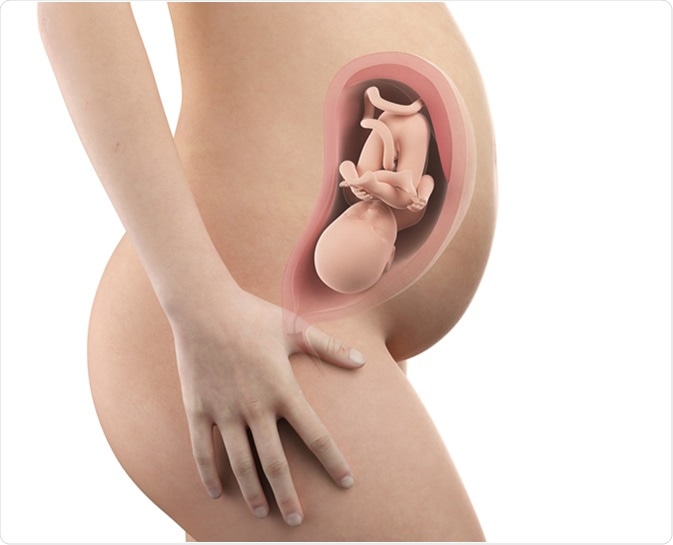Nor.cal for Baby to Not Move as Much
Skip to:
- Is Reduced Fetal Movement Of import?
- Why are Reduced Fetal Movements Worrying?
- Is it Bad When the Babe Moves besides Much?
- How Do We Exam for Fetal Wellbeing?
- Summing Up

Image Credit: Gorodenkoff / Shutterstock
Most doctors and significant women would say they experience more than at ease when the baby is moving regularly. A fetal motion (kick, roll, or flutter) is normally start perceived at xviii to 20 weeks of pregnancy.

Pregnant woman with visible uterus and fetus calendar week 19 - IllustrationImage Credit: Sebastian Kaulitzki / Shutterstock
The number of movements increases steadily until nearly 32 weeks of pregnancy, and then remains more or less constant until the baby is born.

Pregnant woman with visible uterus and fetus week 32 - IllustrationImage Credit: Sebastian Kaulitzki / Shutterstock
Near babies remain notwithstanding while they sleep, for about ninety minutes or less at a time. At other times, they may be felt to movement for episodes lasting 20 to forty minutes throughout the day.
Individual babies have their own patterns of movement. Even though the infant is short of room at the end of a pregnancy, considering of increasing fetal weight, fetal movements remain potent and regular. However, if the babe doesn't movement well for a long time, something may be incorrect.
Is Reduced Fetal Movement Important?
Almost half of all meaning women who accept access to medical intendance may ask for assistance considering of perceived reduction in fetal movements.
Sometimes this is due to factors such as excessive fluid around the baby, unusual fetal position, an anterior placenta, an overweight mother, a first-time mother, or a history of smoking.
Sometimes the mother doesn't notice fetal movements because they are distracted. In near of these cases the babe is healthy.
However, decreased fetal movement may indicate a college risk of fetal affliction or death in about 25% of cases, chiefly because of impaired oxygen and blood supply. In cases of intrauterine death, the fetal movements cease birthday for 24 hours or more than beforehand. Therefore, in cases similar these the health of the infant must be checked.
The well-nigh common way to differentiate between a false and true perception of altered fetal movements is to do the and then-called 'kick count'. All the same, in cases where the baby's health is compromised this exam is not useful equally it is positive only subsequently the infant has suffered permanent impairment.
In practical terms, in many cases the mother's feeling that the baby is moving less is an equally of import indicator of fetal distress.
Why are Reduced Fetal Movements Worrying?
In many cases, reduced fetal movements take been related to lower growth rate and a higher charge per unit of stillbirth.
With depression placental flow, the baby moves less to recoup for its insufficient placental supply. However, babies typically move more when they are hungry, or when the claret carbohydrate level in the female parent drops.
If this is absent, it could point that the baby is so weak that it cannot fifty-fifty seek nutrient, and therefore needs urgent help.
Another reason for reduced fetal movements can exist the result of the mother supplying too much blood sugar to the baby, equally in maternal diabetes or prediabetic states. This is considering oxygen is used to metabolize glucose, leaving picayune for fetal activity.
Is it Bad When the Baby Moves too Much?
Fetal movements typically increment when the mother is hungry, reflecting lowered blood carbohydrate levels in the mother and fetus. This is similar to the increased activity of most animals when they are seeking nutrient, followed past a period of quietness when they are fed.
Information technology is possible that smaller babies move more when they are hungry or when their blood sugar level is dropping, because they are already receiving less food via the placenta for some reason, compared to larger babies with a good placental supply.
A more serious phenomenon is the occurrence of a single sudden episode of unusually vigorous fetal movements at the finish of a pregnancy.
This has been linked in one study to a sevenfold gamble of stillbirth. Several possible causes are listed, including lack of oxygen supply or infection leading to seizures, or the fetus trying to get gratuitous of the umbilical cord entangled around some part of the torso.
This blazon of movement, described as "frantic" or "crazy", is in dissimilarity to the increased strong and frequent movements felt in normal pregnancy towards term.
How Do We Exam for Fetal Wellbeing?
Ways to check if the alter in fetal movement is of concern include:
- Cardiotocography, where the fetal eye rate is observed for its baseline rate and short-term variability, every bit well equally for accelerations with fetal motility, is normal in 97% of active fetuses. Isolated late decelerations with other features existence normal are not usually a sign of fetal distress as previously thought, as in many cases they are due to fetal breathing movements, a sign of fetal wellness.
- Doppler ultrasound can aid detect early signs of poor placental blood supply and poor fetal growth (FGR, fetal growth restriction), typically only after almost a third of the placenta is affected, in the form of altered blood menstruum through the umbilical artery and veins. This method is more than commonly used in Europe than the United states of america.
- Fetal biophysical profile is another method used to assess fetal health, but aberration is generally very belatedly to occur, though one study showed information technology to be more sensitive in predicting a poor delivery outcome than Doppler ultrasound of the umbilical artery
Normal Fetal Movement and Growth | Kaiser Permanente
Summing Upwardly
It is recommended that if a female parent feels any more momentary change in fetal movements, the healthcare provider should confirm that the infant is well.
Formal fetal motion counts of some accepted type may be performed to accurately find this blazon of change. However, these tests have not however been proved to exist reliable in identifying babies at gamble of distress or death earlier it is too belatedly to intervene successfully.
Sources
- Linde A., et al., (2019). Fetal movement in late pregnancy – a content analysis of women's experiences of how their unborn infant moved less or differently. BMC Pregnancy and Childbirth. https://dx.doi.org/ten.1186%2Fs12884-016-0922-z
- Lai J., et al., (2019). Fetal movements every bit a predictor of health. Acta Obstetricia et Gynecologica Scandinavica. https://doi.org/10.1111/aogs.12944
- Bradford B., et al., (2014). Fetal response to maternal hunger and satiation – novel finding from a qualitative descriptive study of maternal perception of fetal movements. BMC Pregnancy and Childbirth. https://doi.org/ten.1186/1471-2393-14-288
- Mangesi L., et al., (2015). Fetal movement counting for cess of fetal wellbeing. Cochrane Database of Systematic Reviews. doi: ten.1002/14651858.CD004909.pub3/epdf/standard
- Heazell A. E. P., et al., (2018). Excessive fetal movements are a sign of fetal compromise which merits further examination. Medical Hypotheses. doi: 10.1016/j.mehy.2017.12.024
- Rayburn Due west. F., et al., (1983). Excessive fetal action: another worrisome sign? Southern Medical Journal. https://doi.org/10.1097/00007611-198302000-00005
- Stacey T., et al., (2011). Maternal Perception of Fetal Activity and Tardily Stillbirth Run a risk: Findings from the Auckland Stillbirth Study. Birth. https://doi.org/10.1111/j.1523-536X.2011.00490.10
- Heazell A. E. P., et al., (2017). Stillbirth is associated with perceived alterations in fetal activity – findings from an international case control study. BMC Pregnancy and Childbirth. https://doi.org/ten.1186/s12884-017-1555-6
- Unterscheider J., et al., (2009). Review: Reduced fetal movements. The Obstetrician & Gynaecologist. obgyn.onlinelibrary.wiley.com/doi/pdf/10.1576/toag.xi.4.245.27527
Source: https://www.news-medical.net/health/What-Does-it-Mean-if-Your-Baby-is-Very-Active-or-Very-Still-During-Pregnancy.aspx
0 Response to "Nor.cal for Baby to Not Move as Much"
Post a Comment